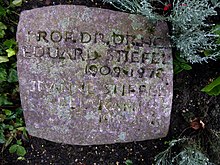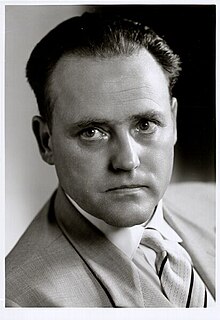Eduard boots
Eduard Ludwig Stiefel (born April 21, 1909 in Zurich ; † November 25, 1978 there ) was a Swiss mathematician .
biography

Eduard Stiefel was born on April 21, 1909, the son of the famous painter and graphic artist Eduard Stiefel of the same name in Zurich. He went through the schools in his hometown and studied mathematics and physics at the ETH Zurich from 1927 to 1931 . He graduated with distinction in 1931 and continued his studies in Hamburg and Göttingen . In 1935 he did his doctorate at the ETH with Heinz Hopf with the dissertation: Directional fields and far parallelism in n-dimensional manifolds. After a time as a research assistant, he became a private lecturer in 1942 and a full professor at ETH in 1943.
Stiefel began working in topology, including a. about the topology of Lie groups and fiber bundles. A variety of characteristic classes is named after him ( Stiefel-Whitney classes ). His classification of fiber bundles on spheres is also used in the classification of algebras (presented by Friedrich Hirzebruch in Heinz-Dieter Ebbinghaus et al .: Numbers , Springer 1992). Later he turned completely to numerical mathematics. He headed the Institute for Applied Mathematics at the ETH, founded in 1948, for which he tracked down a Z4 from Konrad Zuse in Bavaria in 1949 , which Zuse rented for the ETH and started up again. The ETH was thus the first university on the European continent with a programmable calculating machine with which, for example, the gravity wall of a dam was calculated. Boot later sent his assistants Heinz Rutishauser and Ambros Speiser to the USA to study calculating machines, from which the ETH-own development ERMETH emerged , which was in operation from 1955 to 1963.
Stiefel also worked on celestial mechanics, specifically the computation of satellite orbits, and perturbation theory in general. A regularization method developed by him and Paul Kustaanheimo that uses spinors and a transformation in four-dimensional space is named after him. Stiefel received research contracts from the European ESA (or its predecessor ESRO ) and NASA . From 1966 to 1970 he was President of the Swiss Committee for Spatial Research.
Stiefel, who edited Issai Schur's lectures on representation theory at ETH in 1936, wrote a. a. one book on group theory and one on descriptive geometry.
In 1952 he and Magnus Hestenes developed the conjugate gradient method in numerical linear algebra .
In 1956 he was President of the Swiss Mathematical Society . 1970 to 1974 he was President of the Society for Applied Mathematics and Mechanics .
He was a member of the Norwegian Academy of Sciences and the Leopoldina and was an honorary doctor of the Katholieke Universiteit Leuven (Leuven, 1971), the University of Würzburg (1974) and the University of Braunschweig (1975). In 1968 he was a visiting professor at the Free University of Brussels . Stiefel was also a colonel in the artillery in the Swiss Army and from 1958 to 1966 on the Zurich City Council for the National Ring of Independents .
In 1954 he gave a plenary lecture at the International Congress of Mathematicians in Amsterdam ( Recent developments in relaxation techniques ).
At Stiefel, u. a. Ambros Speiser , Peter Henrici , Urs Kirchgraber , Fritz-Rudolf Güntsch and Max Rössler .
Fonts
- Directional fields and far parallelism in n-dimensional manifolds. In: Commentarii Mathematici Helvetici . Volume 8, 1935/1936, pp. 305-353 , (dissertation).
- About directional fields in projective spaces and a sentence from real algebra. In: Commentarii Mathematici Helvetici. Volume 13, 1940/1941, pp. 201-218 .
- About a relationship between closed Lie groups and discontinuous movement groups of Euclidean spaces and their application to the enumeration of simple Lie groups. In: Commentarii Mathematici Helvetici. Volume 14, 1941/1942, pp. 350-380 , (classification of the simple Lie groups).
- Crystallographic determination of the characters of the closed Lie groups. In: Commentarii Mathematici Helvetici. Volume 17, 1944/1945, pp. 165-200 .
- Textbook of descriptive geometry (= textbooks and monographs from the field of exact sciences. 11, ZDB -ID 503783-9 = textbooks and monographs from the field of exact sciences. Mathematical series. 6). Birkhäuser Basel 1947.
- With Heinz Rutishauser , Ambros Speiser : Program-controlled digital computing devices (electronic computing machines). In: Journal for Applied Mathematics and Physics (ZAMP). Part 1: Volume 1, No. 5, 1950, pp. 277-297, doi : 10.1007 / BF02112364 ; Part 2: Volume 1, No. 6, 1950, pp. 339-362, doi : 10.1007 / BF02008909 ; Part 3: Volume 2, No. 2, 1951, pp. 1-25, doi : 10.1007 / BF02589810 ; Conclusion: Volume 2, No. 2, 1951, pp. 63-92, doi : 10.1007 / BF02586200 ; (Together: (= messages from the Institute for Applied Mathematics at the Swiss Federal Institute of Technology in Zurich. 2, ISSN 0514-8146 ). Birkhäuser, Basel 1951).
- About some relaxation calculation methods. In: Journal for Applied Mathematics and Physics (ZAMP). Volume 3, No. 1, 1952, pp. 1-33, doi : 10.1007 / BF02080981 .
- Relaxation methods best strategy for solving linear systems of equations. In: Commentarii Mathematici Helvetici. Volume 29, 1955, pp. 157-179 .
- Introduction to numerical mathematics (= guidelines for applied mathematics and mechanics. 2, ZDB -ID 504059-0 ). Teubner Stuttgart 1961, (English: Introduction to numerical mathematics. Academic Press, New York NY 1963).
-
Methods of mathematical physics. 2 (in 3) volumes. Verlag der Fachvereine, Zurich 1965–1974;
- Volume 1: Held in SS 1965 at the ETH in Zurich. 1965;
- Volume 2: Held in the summer semester 1966 at the ETH in Zurich. 1968;
- Volume 2a: Representation theory with additions. 1974, ISBN 3-7281-0914-2 .
- The renaissance of celestial mechanics. In: Elements of Mathematics . Volume 19, No. 5, 1964, pp. 97-15 .
With Paul Kustaanheimo : Perturbation theory of Kepler motion based on spinor regularization. In: Journal for pure and applied mathematics . Volume 218, 1965, pp. 204-219 .
- With Hans R. Schwarz, Heinz Rutishauser: Numerics of symmetrical matrices (= guidelines for applied mathematics and mechanics. 11). Teubner Stuttgart 1968.
- With Gerhard Scheifele: Linear and regular celestial mechanics. Perturbed two-body motion, numerical methods, canonical theory (= basic teachings of the mathematical sciences . 174). Springer, Berlin et al. 1971, ISBN 3-540-05119-8 .
- With Urs Kirchgraber : Methods of analytical perturbation calculation and their applications (= guidelines for applied mathematics and mechanics. 44). Teubner, Stuttgart 1978, ISBN 3-519-02346-6 .
- With Albert Fässler: Group theoretical methods and their application. An introduction with typical examples from natural and engineering sciences (= guidelines for applied mathematics and mechanics. 46). Teubner, Stuttgart 1979, ISBN 3-519-02348-2 (English: Group theoretical methods and their applications. Birkhäuser, Boston MA et al. 1992, ISBN 3-7643-3527-0 ).
literature
- Jörg Waldvogel, Urs Kirchgraber, Hans R. Schwarz, Peter Henrici: Eduard Stiefel (1909–1978). (Obituary). In: Journal for Applied Mathematics and Physics (ZAMP). Volume 30, No. 1, 1979, pp. 135-140, doi : 10.1007 / BF01597489 .
- Martin H. Gutknecht: Numerical analysis in Zurich - 50 years ago. In: Bruno Colbois, Christine Riedtmann , Viktor Schroeder (eds.): Math.ch/100. 1910-2010. European Mathematical Society Publishing House, Zurich 2010, ISBN 978-3-03-719089-0 , pp. 279-290, ( online, pdf ).
- Ulf Hashagen : Boots, Eduard. In: New German Biography (NDB). Volume 25, Duncker & Humblot, Berlin 2013, ISBN 978-3-428-11206-7 , pp. 321-323 ( digitized version ).
Web links
- Eduard Stiefel in the Mathematics Genealogy Project (English)
- John J. O'Connor, Edmund F. Robertson : Eduard Stiefel. In: MacTutor History of Mathematics archive .
- Zehnder on early computers at ETH
- Biography, especially on celestial mechanics
- Evelyn Boesch Trüeb: Boots, Eduard. In: Historical Lexicon of Switzerland .
Individual evidence
- ↑ ETH Library: Brief portrait of Eduard Stiefel, here online
- ^ Karl-Eugen Kurrer : The History of the Theory of Structures. Searching for Equilibrium. 2nd edition. Wiley, Ernst & Sohn, Berlin 2018, ISBN 978-3-433-03229-9 , pp. 874 f.
| personal data | |
|---|---|
| SURNAME | Boots, Eduard |
| ALTERNATIVE NAMES | Stiefel, Eduard Ludwig |
| BRIEF DESCRIPTION | Swiss mathematician |
| DATE OF BIRTH | April 21, 1909 |
| PLACE OF BIRTH | Zurich , Switzerland |
| DATE OF DEATH | November 25, 1978 |
| Place of death | Zurich , Switzerland |

